Fantasy MPEG movie to a black hole
Gravity causes stars to have multiple images. Two images of the constellation of Orion are particularly apparent.- Approaching the black hole. (182 k; explanation)
- Circling the black hole at some distance. (819 k; explanation)
- Approaching the photon sphere. (140 k; explanation)
- Looking up at the photon sphere. (46 k; explanation)
- Circling the black hole at the photon sphere. (452 k; explanation)
Still curious about black hole properties? Here Matt McIrvin answered some frequently asked questions about black holes to the internet newsgroup sci.physics.
All movie frames, text, and computer codes are written, edited, and
copyrighted by Robert J. Nemiroff in 1994 and 1995 unless noted otherwise.
They are not to be disseminated without his written permission. NASA is
gratefully acknowledged for providing computer support for this educational
project.
Current average number of accesses to this page per day: about 300.
Fantasy MPEG movie to a neutron star
The surface of the Earth has been mapped onto the neutron star
to better allow the observer to follow the visual distortion effects caused
by the high gravitational field.
Fantasy MPEG movie to an ultracompact star
Note the color changes for the stars and surface as they get redshifted
and blueshifted. The constellation Orion is visible in most sequences -
can you find it?
Three other WWW astronomy education projects I help coordinate:
Astronomy Picture of the Day,
Great Debates in Astronomy held at the Smithsonian
in Washington, DC,
The Astrophysics Source Code Library (ASCL or ASCL.net)
is a free, on-line library housing source codes of all sizes
that are of interest to astronomers and astrophysicists.
Robert Nemiroff
(nemiroff @at@ mtu .dot. edu)

